If the onset of summer is measured in square inches of skin (revealed by way of micro miniskirts, peekaboo crochet and heat-reactive dresses), then winter marks its arrival in shades of outerwear. Chilly temperatures herald an onslaught of Uniqlo’s Ultra Light Down. By the first frost, the sidewalks are covered in the familiar two-tone of The North Face’s Nupste. Snow or sleet calls for something studier — a Moncler, perhaps?
When it comes to winter weather, the puffer reigns supreme. Outside of the usual suspects, however, a handful of innovative labels are proving that there’s a puffer for all seasons. For all your transitional weather needs, Goom Heo’s here to provide baffling mini dresses and the requisite leg warmers. What about an ultra-cropped puff for summer? Sia Arnika’s got you covered – or not so much! And if you’re taking a sojourn into the metaverse, Chen Peng has just the NFT for you. With their sexy, surreal and summer-ready garments, these designers are redefining the puffer jacket, pushing it far beyond its utilitarian origins and into the realm of statement wear.
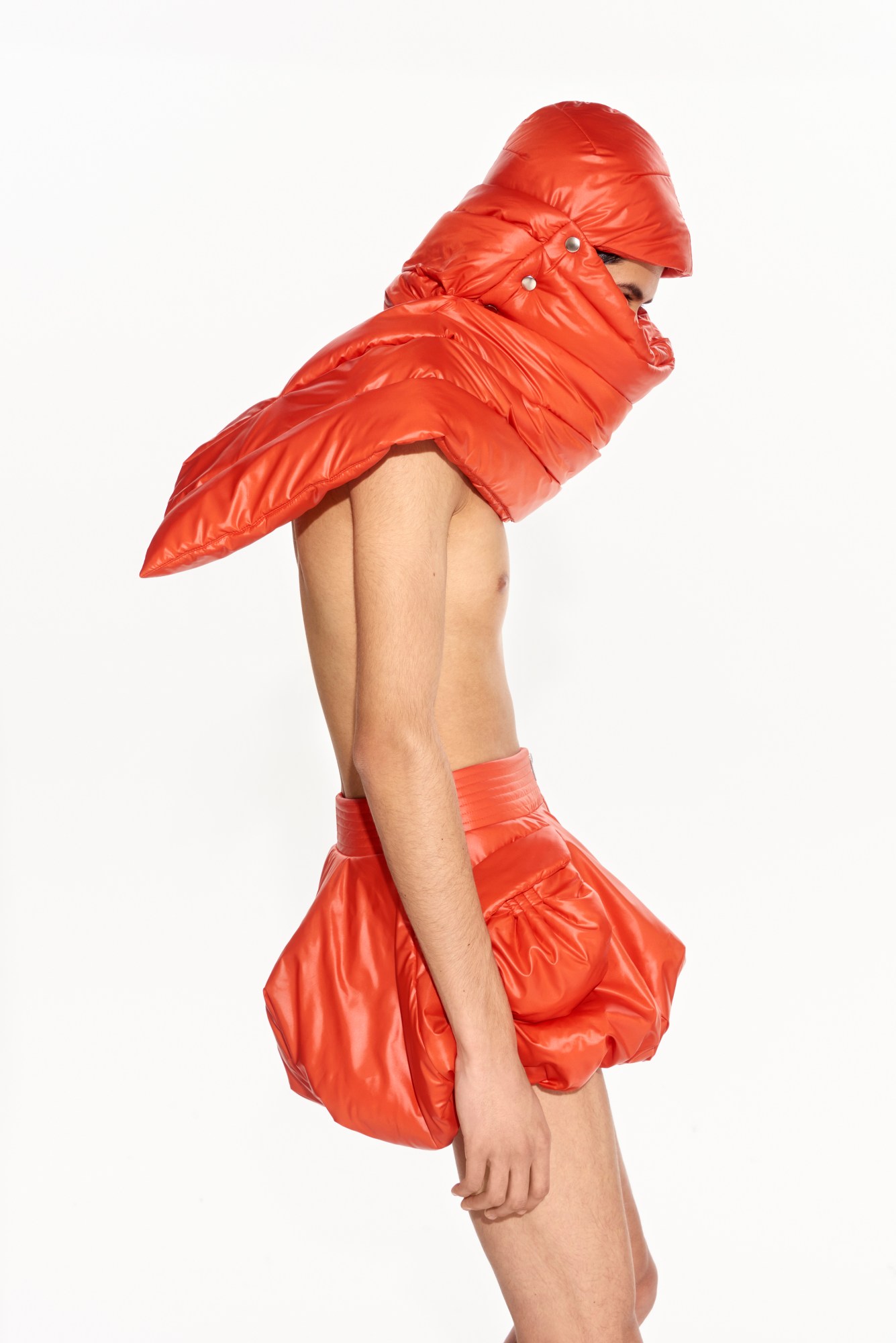
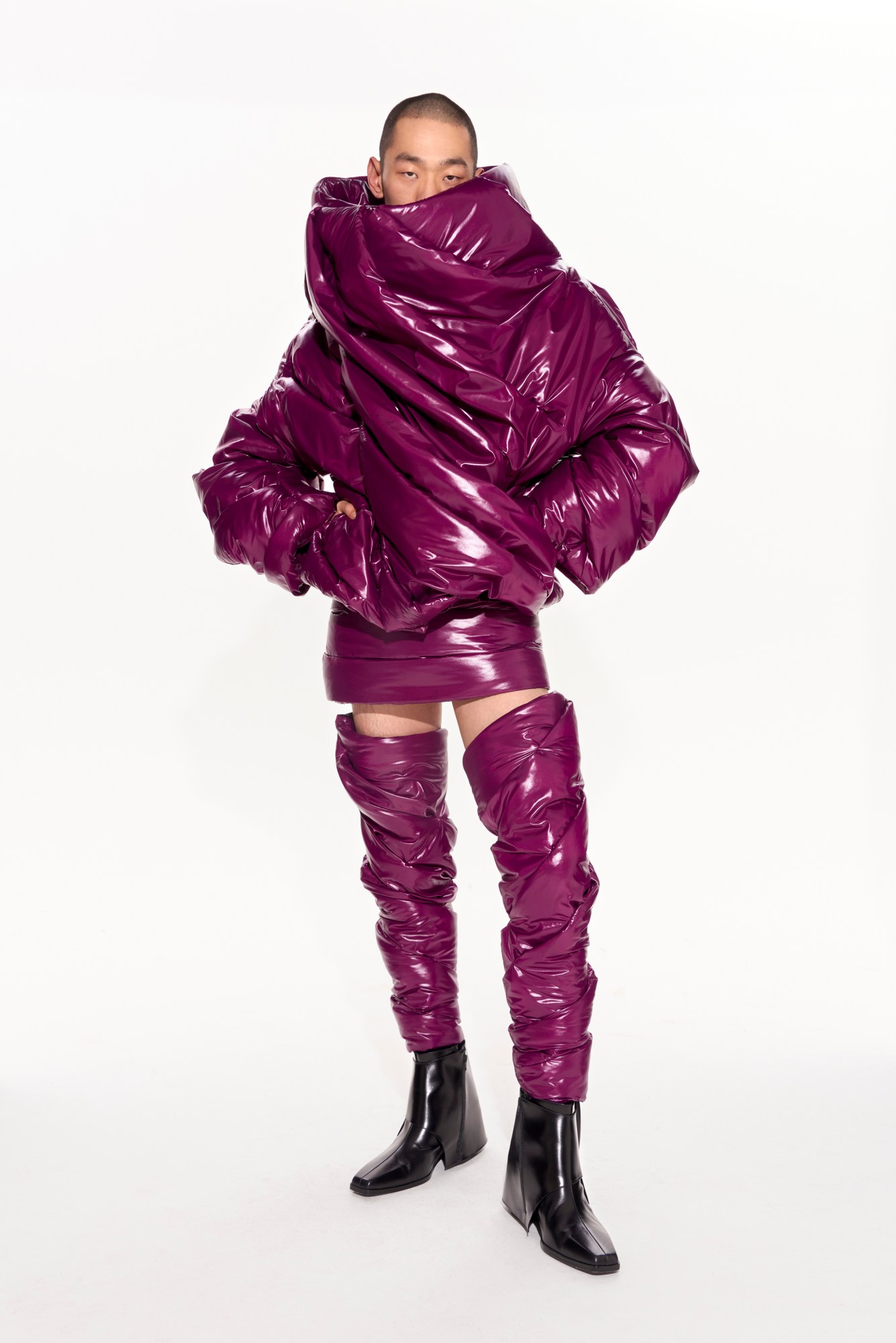
Goom Heo
Born in South Korea, Goom Heo moved to London to found her eponymous label, GOOMHEO. “Genderless, fluid aesthetics” permeate Goom’s menswear garments, which highlight the similarities and differences between typically masculine and feminine design elements.
What’s the concept behind your AW22 collection, titled Infinite Glacier?
Through our AW22 collection, I wanted to experiment with new ways of defining what “genderless” means to GOOMHEO. In terms of design, icy, cold and stiff structures were the main keywords that initiated this collection.
Conventionally, puffer jackets are worn to protect from the cold and provide warmth. Why and how were you challenging the purpose of the puffer jacket with your AW22 puffer pieces?
Our puffer jacket and vest were the very first designs we developed when we began our AW22 collection. The idea was simple: we’d been using this draping technique quite often in the past few seasons and I wanted to do something new with the puffer jacket. I asked my team if they’d seen any draped puffer pieces and we all agreed that it’s quite fresh, visually, but also challenging and sounded fun to develop.
How do you envision the relationship with aesthetics and utility when it comes to your work?
I believe aesthetics are important but if I want to see real people wearing my garments, which makes my world a reality, utility is also important to consider. I don’t think all the pieces need to be useful, functional garments. Think of some clothes you have in your wardrobe that you only wear when you want to dress up, or something you want to archive because you just love it even though it’s not useful, or something that’s uncomfortable to wear but you feel fabulous in it. I believe we all have at least one of these pieces.
How does the body inform your work?
To me, garments play differently and have a different mood or character depending on who is wearing them.

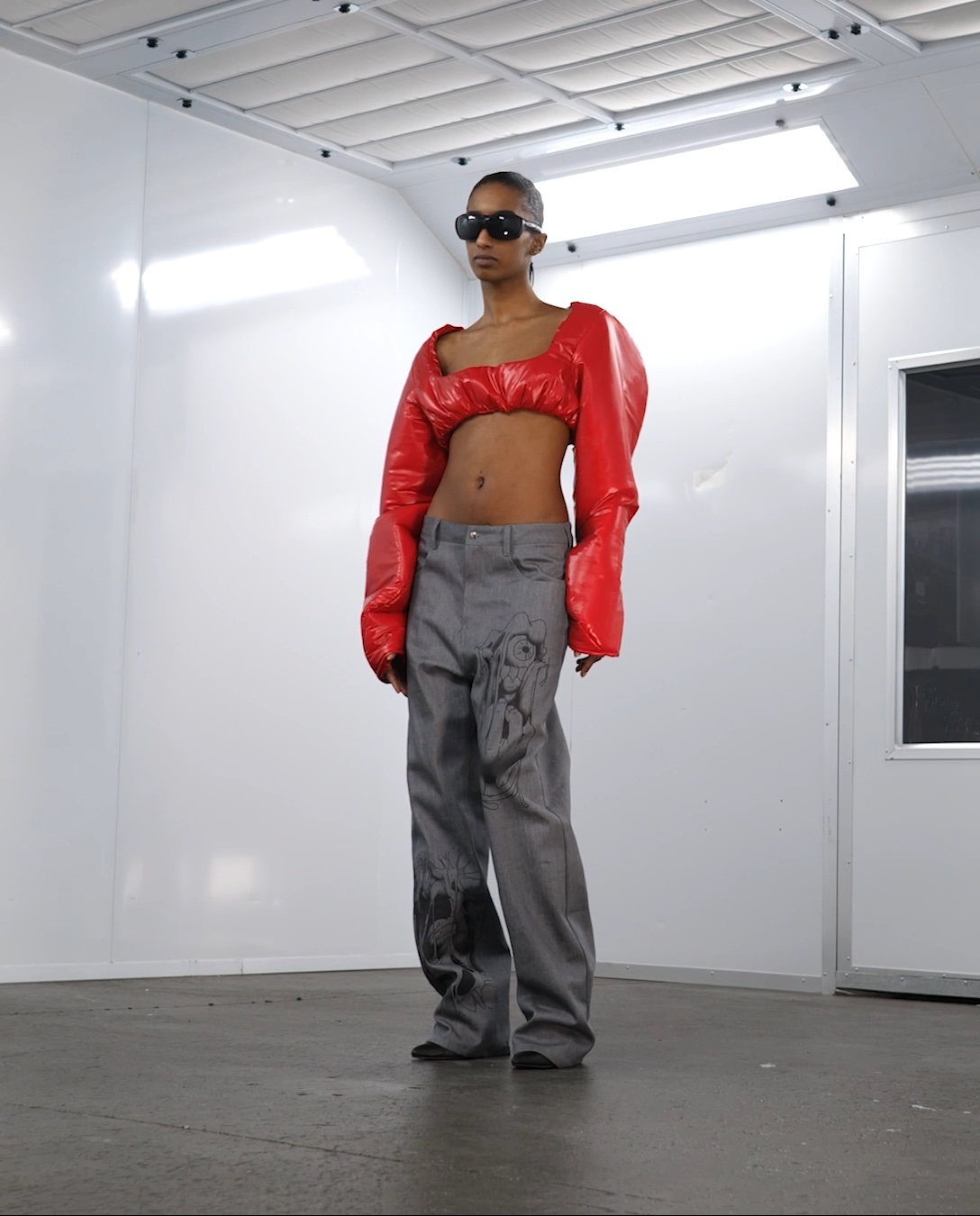
Sia Arnika
After an idyllic childhood spent on the Danish island of Mors, Sia Arnika moved to the bustling metropolis of Berlin in the early 2010s. Nearly a decade later — at the beginning of the pandemic — she founded her namesake womenswear label, which explores the possibilities of hybridity in fashion.
What’s the concept behind your AW22 collection?
When I was putting the collection together I had this one film character in my head. She lives somewhere in between Sin City and Chinatown. It’s a classic neo-noir tale of a babe mixed up with the wrong crowd, where all of the players have a past they’re trying to escape from. It’s a dark tale filled with mystery and suspense.
Conventionally, puffer jackets are worn to protect from the cold and provide warmth. Why and how were you challenging the purpose of the puffer jacket with your new puffer pieces?
I like to refer to what I do as experimental normality: to decipher the codes of a garment and put it together in a way that questions the originality. The oversized collar puffer from my AW22 collection was a continuation of a puffer idea from my AW21 collection. It’s a puffer jacket turned on its head and draped around the shoulders. It’s like wrapping yourself up in a sleeping bag, constructing a sense of adventure. There is also something very sci-fi about the mixture of shiny smooth texture and the rigidness of the structure.
How do you envision the relationship between aesthetics and utility when it comes to your work?
I like to think of it as a mutual beneficiary one. What drives me is the investigation of two opposing forces and finding a way for them to exist within the same narrative. Minimalism and maximalism as partners. So why can’t an aesthetically exciting garment be functional and vice versa?
How does the body inform your work?
I would rather say that I work with identity play, using the body as a medium. Whereas there are natural boundaries of the human body, using garments can change the perception with artificial shapes. There is no end to the possibilities.
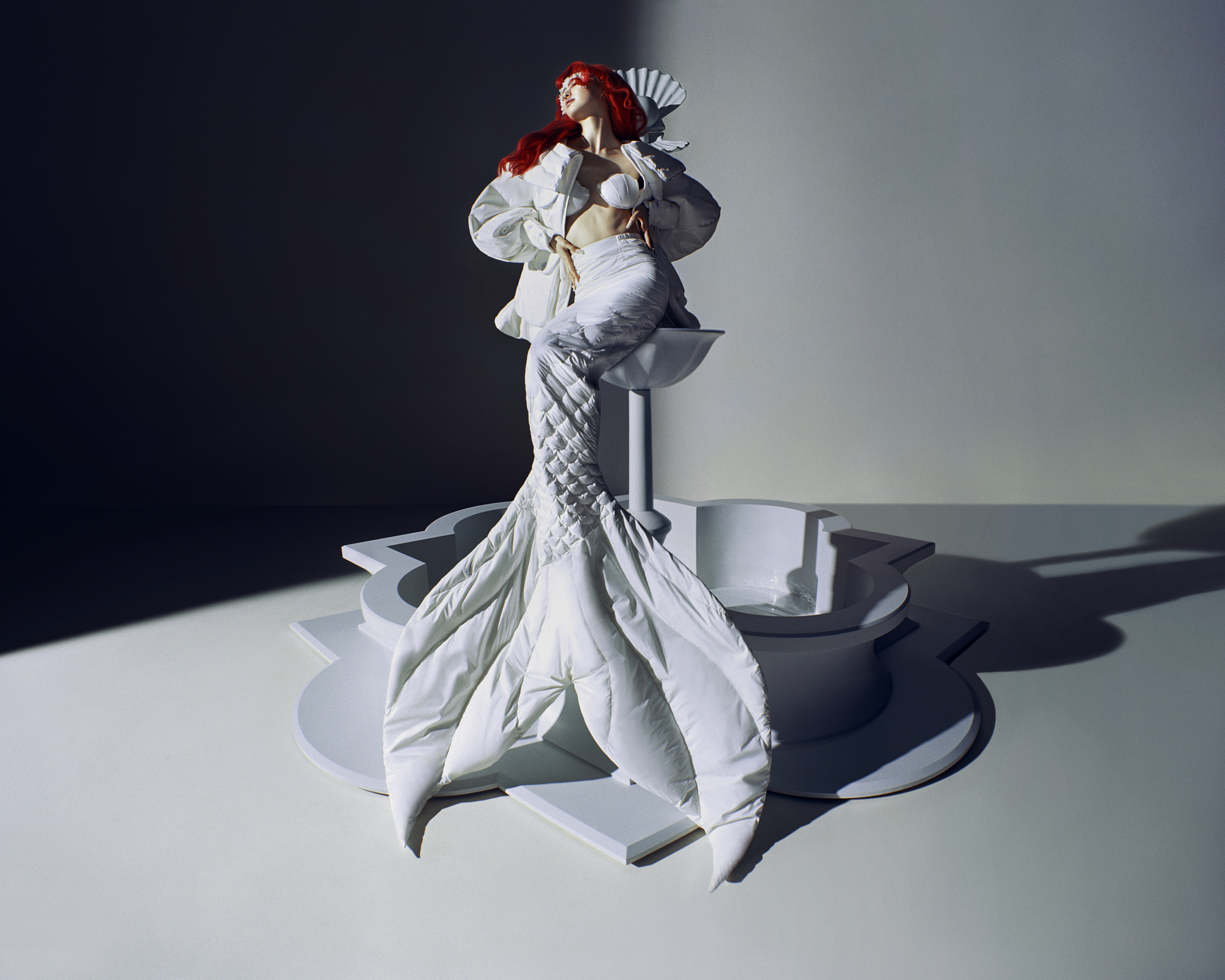
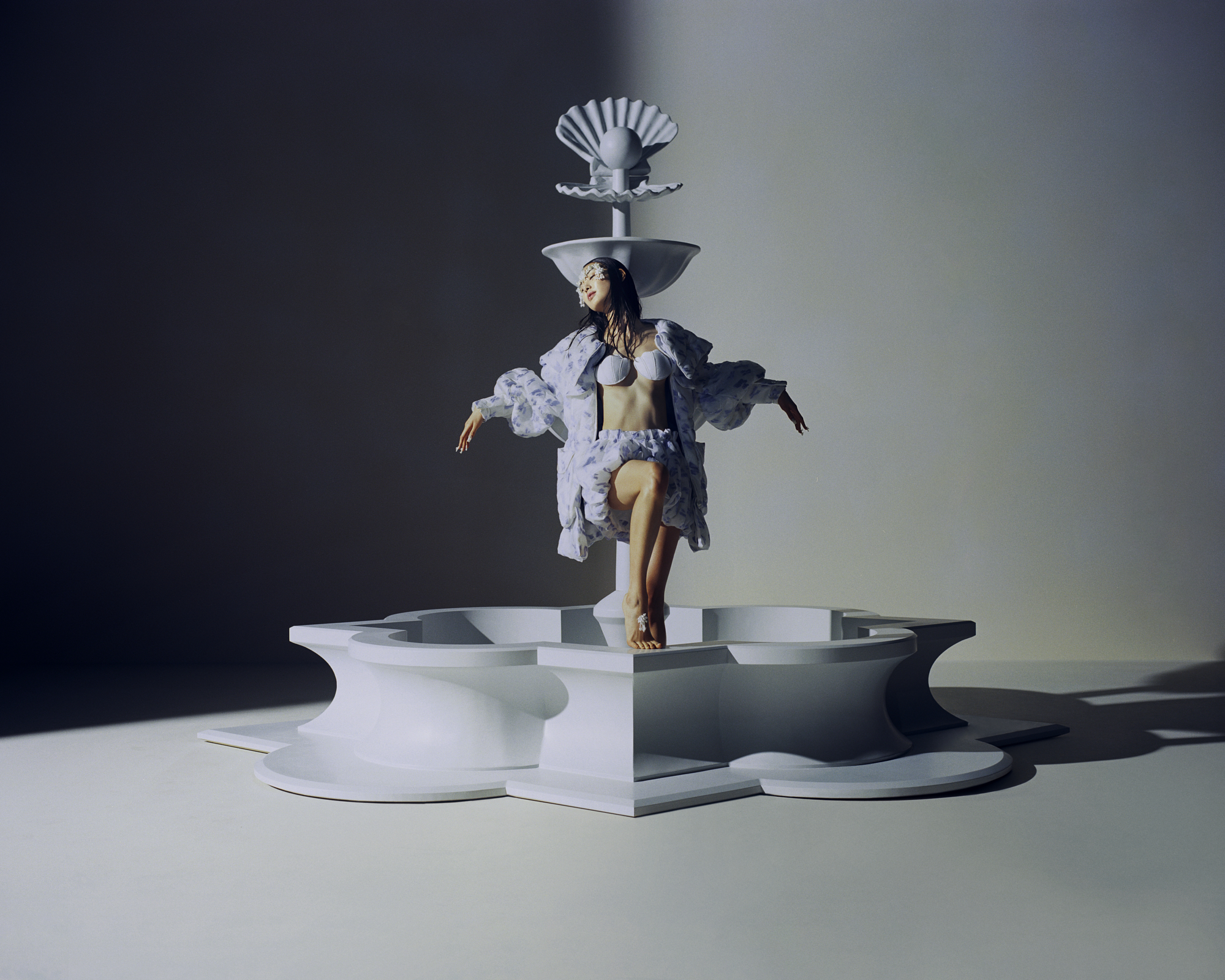
Chen Peng
Growing up in China’s “Porcelain Capital”, designer Chen Peng was fascinated by art from a young age. After completing his graduate studies at London College of Fashion, he launched CHENPENG with the puffer jacket as the label’s signature.
The puffer jacket is your design signature. What drew you to this garment as the basis of your label?
When I was a graduate student, the reason I studied body shape was that my good friend was very big, but my body shape was relatively thin, so it was often difficult for us to find clothes that fit our fashion aesthetics. I began to study how to create clothing structures and silhouettes suitable for various shapes, hoping to give the public more simple choices. After several different tests, I found that down is the perfect material for expressing the distribution of fat in human musculature. So my first work came out to be a puffer jacket, which then became a full collection. The puffer remains to be the key and gene of my brand.
Conventionally, puffer jackets are worn to protect from the cold and provide warmth. Why and how does your body of work challenge the conventions of the puffer jacket?
At the time I was studying at London College of Fashion, the fashion industry still had strict requirements for body shape. I founded CHENPENG hoping to express my fashion attitude to the world, that fashion is not limited by body, race, gender and age. My label advocates for a more equal and diversified lifestyle. I express my understanding of confidence, courage, love, freedom and equality through bold color matching, diversified fabrics and unique silhouettes. In my design aesthetics, there are no boundaries between beauty and ugliness. To define my brand in one sentence, CHENPENG is full of imagination, infinite possibility and marvelous vitality.
How do you envision the relationship between aesthetics and utility when it comes to your work?
“Aesthetics” is the soul, “utility” is the body. The soul needs the body as its carrier, the business model needs aesthetics to convey its content. The biggest difference between “art” and “product” is how much the creator wants the audience to understand his heart.
In your own words, what’s the concept behind your latest collection?
This March, we launched an NFT collection The World as I See. It depicts six unique, surreal worlds where humans interact with nature. Set against the backdrops of the forest, the volcano, the desert, the glacier and the ocean, it reveals the six psychological states of existence during the post-pandemic era. In these worlds, clothes are no longer the exterior but rather a co-existence — like one’s flesh and bones.



